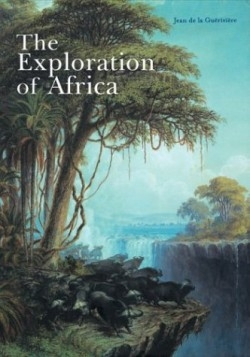
The Exploration of Africa
“In the region of the unknown, Africa is absolute.” Since Victor Hugo made this comment in the 1880s, thousands of books have shed light on the Dark Continent. Most authors, including the popular recent trio of Alan Moorehead, Christopher Hibbert, and Thomas Pakenhan, have settled for a brace of rivers or a specific time period or topic. This handsome oversized (13 ¼ x 9 ½ inches) volume is more ambitious, targeting the entire continent from Roman times to the present. Overall it is a great success, with few if any rivals in its field. The author, an old African hand with twenty-five years of traveling and writing behind him, including heading the Africa/Asia department of the leading French newspaper Le Monde, powerfully evokes the players and the places, and has added remarkable pictorial support ranging from a Roman wall painting of a whimsical Nile scene to recent photography by Leni Riefenstahl that captures the dignity of endangered indigenous peoples.
De la Guérivière’s approach is broadly thematic rather than narrowly chronological. Geographically driven themes include the quests for the sources of the Nile, the Zambezi, the Niger, and the Congo. He then discusses the appalling greed—and power—fueled European grab for African colonies, second in destructiveness only to the slave trade. His final theme is the late nineteenth-century shift from often arrogant presentation of “heroic” explorers to initially patronizing exhibitions of Africa’s indigenous cultures—in some cases with African people themselves on display—and their effect on European art and design.
De la Guérivière is refreshingly even-handed in giving credit due to explorers other than the French pioneers. Leading British explorers get generous treatment; many less well-known ones receive deserved mention. The author gives welcome acknowledgment to Barth, Rohlfs, Nachitigal, and Schweinfurth, that mighty quartet of industrious German explorer-ethnographers who in the 1850s-1870s traversed much of Africa’s vast northern swathe. Stanley, serving fame and fortune, strides imperially from Zanzibar to Ujiji to find the plodding Dr. Livingstone, serving God and Africa. He later “rescued” the endearing Emin Pasha (a.k.a Dr. Eduard Schnitzer), an erudite German who unwillingly ceased governing Equatoria and, in Mombasa, after a speech about his experiences, shortsightedly exited via a second-floor French window.
Larger-than-life characters abound: James Bruce, Sir Richard Burton and James Speke, Sir Samuel Baker (accompanied by a Hungarian wife purchased in a Bulgarian slave auction) and the indefatigable Brazza among them. All of them, with their ambitions, eccentricities, and achievements, are set in skillfully drawn contexts.
Highly apposite quotations from explorers’ journals abound: Stanley mildly notes, “We possessed salted giraffe and pickled zebra tongues,” but on a more frightening note, Alfred Marche (exploring the Gabon) reports, “The chief…replied that it was a gorilla’s head. No, it’s not, I laughed. It’s a human head. What’s it doing there?” (“there” being his hut). In addition to possible death, explorers constantly faced extortion (“fake pearls to pay rights of passage”), hunger, and disease. The illustrations are first-class: a sublime Benin head, scenes of natural marvels, fauna and flora, panels of ethnographic portraits, man-beast encounters, a circle of dancing natives (surely it inspired Matisse), French-trained African troops and even a radiant Josephine Baker will delight, just as powerful scenes of the horror of slavery will wrench the heart.
Thanks are due to Florence Brutton, an experienced translator, for providing a clear-cut story line and skillful management of supporting detail: the book reads well. Also praiseworthy is the comprehensive bibliography, which lists English-language translations of many older and more recent French language volumes. It is clearly too much to expect a “perfect” book on a topic as huge as the exploration of Africa, and de la Guérivière deals rather too lightly with Roman exploration (expeditions were active in the Red Sea, Ethiopia, and the Sahara), though he usefully introduces three often-neglected early writers on Africa, Ibn Battuta, Leo Africanus, and the estimable Dutch Lutheran Olfert Dapper (whose 1668 “interdisciplinary” book on Benin is essential). Though it may be a shortcoming of the book’s original French publisher, lack of a comprehensive index is a significant deficiency in a book as rich and rewarding as this.
De la Guérivière is the author of three other books on Africa; this is the first to be translated into English. In it, he excels in linking exploration, colonization, and reportage from Africa to the home fronts in the colonizing European nations both before and during the advent of “ethnographic exhibitions” (a.k.a. “human zoos”). Frequent reference to the impact of Africa on Europe gives his book a depth and resonance seldom found in the genre.
Disclosure: This article is not an endorsement, but a review. The publisher of this book provided free copies of the book to have their book reviewed by a professional reviewer. No fee was paid by the publisher for this review. Foreword Reviews only recommends books that we love. Foreword Magazine, Inc. is disclosing this in accordance with the Federal Trade Commission’s 16 CFR, Part 255.
